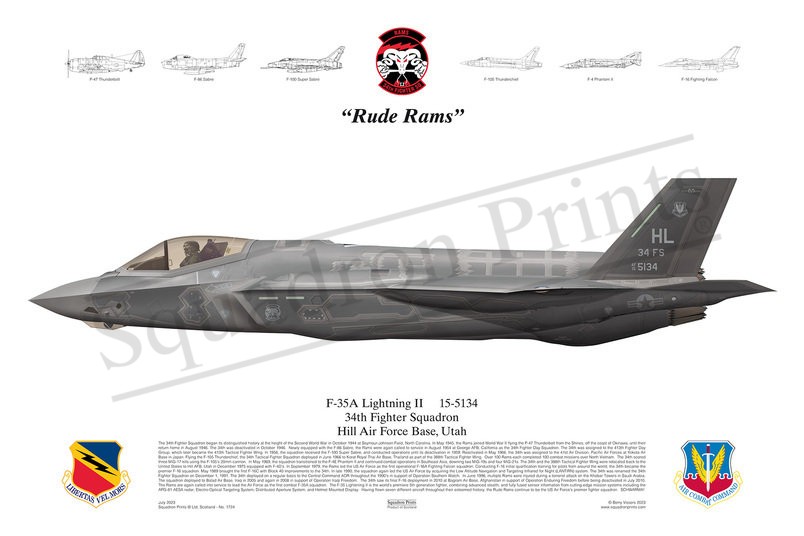#1724 34 FS, F-35A Lightning II print

Description
Squadron Prints Lithograph No. 1724 - 15-5134 '34 FS', F-35A Lightning II, 34 Fighter Squadron, Hill Air Force Base, Utah.
The 34th Fighter Squadron began its distinguished history at the height of the Second World War in October 1944 at Seymour-Johnson Field, North Carolina. In May 1945, the Rams joined World War II flying the P-47 Thunderbolt from the Shines, off the coast of Okinawa, until their return home in August 1946. The 34th was deactivated in October 1946. Newly equipped with the F-86 Sabre, the Rams were again called to service in August 1954 at George AFB, California as the 34th Fighter Day Squadron. The 34th was assigned to the 413th Fighter Day Group, which later became the 413th Tactical Fighter Wing. In 1956, the squadron received the F-100 Super Sabre, and conducted operations until its deactivation in 1959. Reactivated in May 1966, the 34th was assigned to the 41st Air Division, Pacific Air Forces at Yokota Air Base in Japan. Flying the F-105 Thunderchief, the 34th Tactical Fighter Squadron deployed in June 1966 to Korat Royal Thai Air Base, Thailand as part of the 388th Tactical Fighter Wing. Over 100 Rams each completed 100 combat missions over North Vietnam. The 34th scored three MiG-17 kills using the F-105’s 20mm cannon. In May 1969, the squadron transitioned to the F-4E Phantom II and continued combat operations in Southeast Asia, downing two MiG-19s and four MiG-21s. The 34th and the 388th Tactical Fighter Wing were relocated back to the United States to Hill AFB, Utah in December 1975 equipped with F-4D’s. In September 1979, the Rams led the US Air Force as the first operational F-16A Fighting Falcon squadron. Conducting F-16 initial qualification training for pilots from around the world, the 34th became the premier F-16 squadron. May 1989 brought the first F-16C with Block 40 improvements to the 34th. In late 1990, the squadron again led the US Air Force by acquiring the Low Altitude Navigation and Targeting Infrared for Night (LANTIRN) system. The 34th was renamed the 34th Fighter Squadron on December 1, 1991. The 34th deployed on a regular basis to the Central Command AOR throughout the 1990’s in support of Operation Southern Watch. In June 1996, multiple Rams were injured during a terrorist attack on the Khobar Towers in Saudi Arabia. The squadron deployed to Balad Air Base, Iraq in 2005 and again in 2008 in support of Operation Iraqi Freedom. The 34th saw its final F-16 deployment in 2010 at Bagram Air Base, Afghanistan in support of Operation Enduring Freedom before being deactivated in July 2010. The Rams are again called into service to lead the Air Force as the first combat F-35A squadron. The F-35 Lightening II is the world’s premiere 5th generation fighter, combining advanced stealth, and fully fused sensor information from cutting-edge mission systems including the APG-81 AESA radar, Electro-Optical Targeting System, Distributed Aperture System, and Helmet Mounted Display. Having flown seven different aircraft throughout their esteemed history, the Rude Rams continue to be the US Air Force’s premier fighter squadron. SCHWARMA!
You may also like
-
Hawk Mk65
8810The Royal Saudi Air Force Aerobatic Team, The Saudi Hawks, 88 SqnTabuk, King Falsal AB
